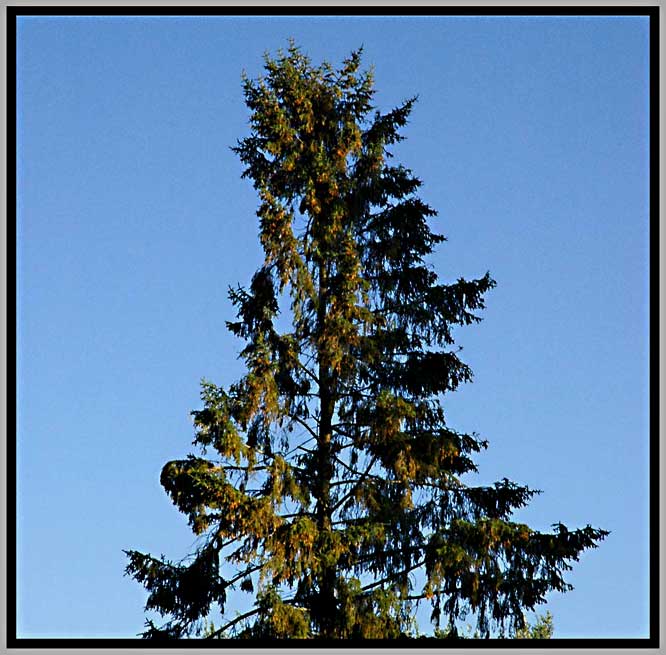
Sick Norwegian Spruce . . . (Picea abies) . . . . Introduce from Europe.

Sick Norwegian Spruce . . . (Picea abies) . . . . Introduce from Europe.
This is the signature conifer of large areas of the Alps
I like to call it Fiddletop Spruce, because its light, responsive,
resonant qualities made it the wood of choice for the top
sounding plates of the famous Stradivari violins. (The backs
were made of the much heavier carved maple.)
Already 100 years ago foresters in the Alps were warning of
the declining health of the Spruce forests, even going so far as to
call attention to this all but sacred relationship between—for those
of us who love the unique sound of the violin—a full vocal timbre
that projects well in space, and healthy spruce trees.
It should give those who study Classical music pause. Indeed, I think
young violinists who are dedicated to mastering the great Western
tradition of string playing should also learn to recognize
a sick Spruce. In the urban landscapes of Northeast America,
Fiddletops are ubiquitous. So are the signs of serious decline:
misshapen crown, a ‘thin foliage look’ because they typically
have only a year or two of needleson their side branches instead
of the normal five or six ; and perhaps most tellingly, the long,
hanging shoots (adventitious) in places where
they shouldn't be.
Once you learn to recognize this illness gestalt, you'll be able
to spot the trees—there’s another FIDDLETOP!—at great distances,
even by their silhouettes at night. The cause of the symptoms
is without a doubt air pollution, and then, in my opinion, mostly
from cars.
Whereas North Americans, in as far as I can see, seem largely
unconcerned about the Spruces, the Europeans are very
concerned. Norwegian Spruce has the largest altitude amplitude
(grows from valley bottom up to sometimes to treeline) of any
species, so it forms the backbone of what is called the
Protection Forest (Schutzwald). The is the band of what tourists
see as beautiful green that literally in many places holds the steep
slopes together, so to speak. Especially during heavy rain, which,
with climate change, is becoming both more frequent and
catastrophic. And, of course, the Protection Forest offers
an essential wall of security during the six months of the
year in which large parts of the Alps are threatened by Winter
avalanches.
I think it's a good thing to teach a child: no heathy forest, no
healthy sound.
NEW: To view / purchase different sized prints of this image at the
PhotoWeek Store click here. view as SLIDESHOW |
[http://www.shutterfly.com/pro/cliffcards/photoweek]
| back to Picture/Poems: Central
Display | go to
P/P Photoweek: Archive
|
|
Map
|
TOC:
I-IV |
TOC:
V-VIII |
Image Index
|
Index
| Text Only
| Download
Page |
Newsletter
|
About
P/P |
About Cliff
Crego |
Photograph by Cliff Crego © 2006 picture-poems.com
(created: IX.10.2005)